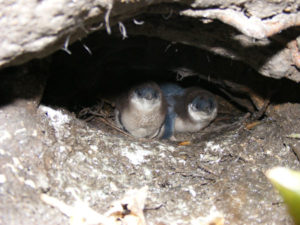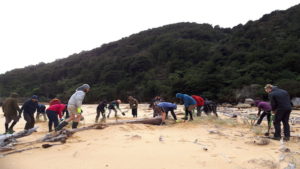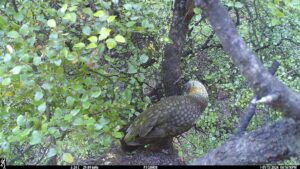The Project Janszoon 2022-23 breeding season for kākā has resulted in six fledged juveniles flying from their nests.
The season had an early start with the first nesting activity recorded as early as October. In total, Project Janszoon has released 35 kākā into the Park, the last in 2019, and it is heartening to see some of these banded birds starting to settle in to breeding, with six pairs observed displaying nesting behaviour this season. In total we’ve recorded 20 kākā chicks fledging from nests we’ve been keeping an eye on since we started releases.
DOC and Project Janszoon staff were kept busy through the summer monitoring kākā breeding activity, using a mix of physical visits and trail cameras set up to record visits by parent birds and any predators, and maintain trapping networks around known nest sites.
Kākā usually nest in hollow trees, and the female birds are particularly vulnerable when nest sitting as rats and stoats can easily get into the nest, attack the chicks and even kill or injure the mother bird.
Kākā incubate for about three weeks, and the chicks fledge between 10 and 12 weeks of age. When fledging, the young birds spend alot of time on the ground around the nest site so they are particularly vulnerable to predators during this phase.
We had some surprises along the way. A karearea/falcon took out a whole clutch of young chicks – evidence that nature doesn’t stand on ceremony and a hungry falcon, probably feeding her own chicks, was caught on camera visiting the nest 16 times.
If possible, chicks are weighed and banded at fledging time, with radio transmitters fitted to female birds so we can keep track of their location for their first few months in the big wide world.
As well as using transmitters to track known birds, we use our Forest Bird Acoustic Monitoring to assess the distribution of kāka in the Park. In 2022, our monitoring programme picked up an obvious increase in kākā. We have a very visble population at Bark Bay, but the monitoring also recorded increases in kākā calls at Anchorage/Torrent Bay, Wainui, and in the upper Buttress and Evans areas. Some of these will be birds we have introduce and chicks born here, but we also suspect that wild birds are being attracted by better food sources, low predator numbers and a ready source of mates.
Kākā are known to be highly vulnerable to predators, and the breeding successes so far have been made possible through the intensive pest control efforts – both on ground traps and aerial control – of Project Janszoon and its Partners DOC and the Abel Tasman Birdsong Trust.
We hope that, as kākā numbers continue to grow naturally, and predator numbers reduce, we could expect to see an upward curve in population size and chick survival. We will be monitoring them but if you see or hear kākā whilst you are out and about in the Park, please use the Abel Tasman App to record sightings and help us gather information about how these incredible birds are doing.
You can read more about Project Janszoon’s kākā restoration work through these links:



